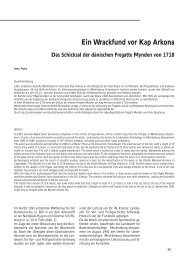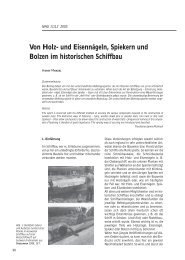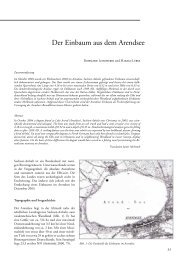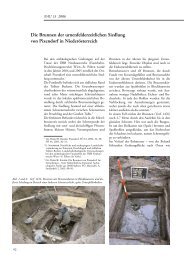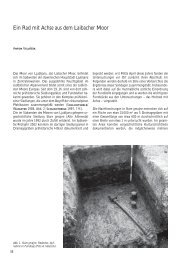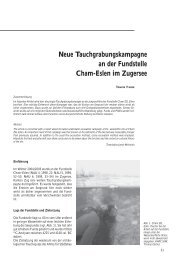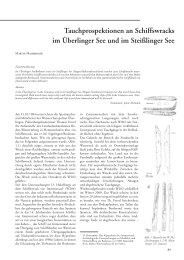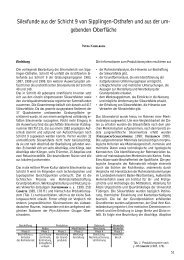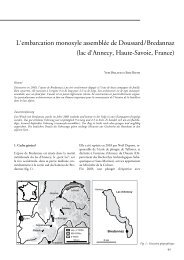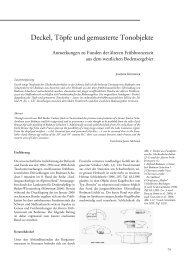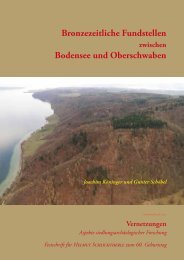Documents - Janus Verlag
Documents - Janus Verlag
Documents - Janus Verlag
Sie wollen auch ein ePaper? Erhöhen Sie die Reichweite Ihrer Titel.
YUMPU macht aus Druck-PDFs automatisch weboptimierte ePaper, die Google liebt.
Skin versus Wood? Probably both!hazel or willow withies. The framework itself isheld together by the tension created as the lathscriss-cross each other, woven as they are like abasket. Over this framework the makeshift gunwalesare formed by plaited hazel withies. Theyare woven around the exposed upright ends ofthe framework. At this point a plank is workedinto the arrangement amidships to serve as aseat. Once complete the framework is coveredoverall with the hide of an ox or horse, the hidebeing held in place by twine. This was then fittedwith a carrying rope made of twisted hazelboughs or a leather carrying strap, that was fittedto the seat. Waterproofing of the hull is accomplishedby the application of animal fats inthe case of hides, and pitch mixed with linseedoil for cloth covers (Greenhill 1976; McGrail1998). The only tools required for the manufactureof coracles is a sharp knife or axe blade tocut and shape the framework elements. The hidecovering can also be processed by use of a sharpknife. The plank used for the seat is the largestand most substantial component of the moderncoracle. This plank can be worked to shape withan axe. In at least one, possibly all three BronzeAge graves from a cemetery at Barns Farm, Dalgety,Fife, a coracle was identified that had beenused as a coffin (Watkins 1980), indicating theirlong history of use in the British Isles.CurraghsCurraghs are skin boats which have an advancedframework structure and can be considered amore developed form of coracle. Curraghs, likecoracles, are built up from a wooden frameworkcovered over with a hide or cloth waterproofinglayer that forms the hull. Longer and narrowerthan coracles, the curragh is designed for use asa coastal fishing vessel. More structurally soundthan the coracle, the curragh is regularly used asa working fishing vessel and persists in its presentuse among the fishing villages of westernIreland where it is regularly used in coastal conditions(Hornell 1938).The material considerations for curraghs aresimilar to those as outlined above for coracles.Some one hundred and fifty years ago curraghsof Donegal were known to be made in rudeform with a frame of withy ribs and stringers,all covered with untanned hide. More recentlycurragh frames are fashioned with single or evendouble gunwales made from split and shapedtimbers and tarred cloth has replaced hide coverings.Like birchbark canoes, curraghs in generalobtain their longitudinal strength from thegunwale frame, without any keel. They also utiliselongitudinal battens to provide support forthe skin cover and continuous transverse framemembers. These features are in contrast to Eskimoumiaks, which have three frame sectionslashed together to form the shell.Another variation of curragh, the Boyne curragh,has a lightweight frame constructed of doubledhazel withies. In general form and constructionthis vessel is more like a coracle, with the exceptionthat the frame is constructed “mouthdown” from hazel branches set into the groundand bent over to form an inverted bowl. This isin contrast to coracles which are built “mouthup” as stones are used to hold the withies to theground and their ends are bent upward and securedby a heavy band of interwoven withies.For this reason the Boyne curragh can be seenas a transitional form between coracle and theother curraghs whose construction commenceswith the building of the gunwale frame and thenproceeds with the attachment of the cross beamribs and longitudinal stringers (Hornell 1938).One would expect that during the Mesolithic itwas also possible to fashion curraghs of saplingsand withies as they were made in Ireland untilrecently. Hazel and birch would have beenaptly suited materials for frame construction duringthe early Mesolithic. Elk or reindeer hideswould have been readily available for the outercovering. The tools necessary to manufacturecurraghs little from those described for thecoracle, a knife and/or axe. Curraghs are knowntoday only from western Ireland. However thenumerous historic accounts of curraghs indicatethat they were widely utilised throughoutthe Celtic regions long before the time of Romanexpansion into western Europe (Marsden1974). Unlike the exotic skin boats of the Eskimo,these vessels were common throughout theFigure 2: Exampleof a modern curragh(Greenhill 1976). Noticethe ribs of slenderbranches and the projectionof the stringersat the bow.11




